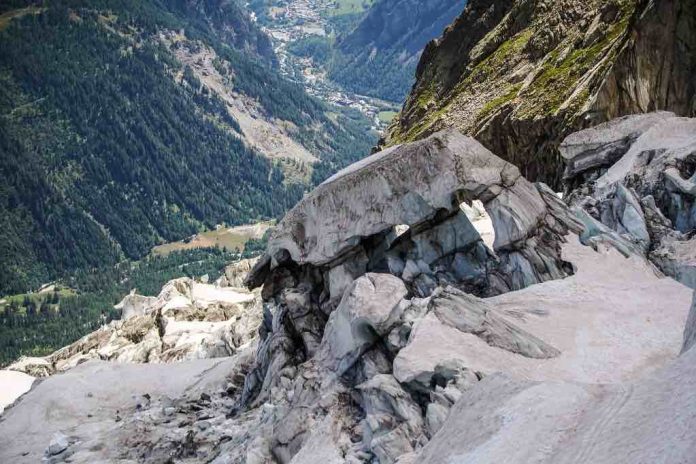An Italian alpine resort remained on high alert on Friday over fears a vast chunk of a glacier on the slopes of the Mont Blanc massif could plummet in high temperatures.
“No one gets through! No cars, bikes or pedestrians,” was the message at a checkpoint where an automatic barrier and two guards blocked the small tarmac road snaking up into a lush valley below the Planpincieux glacier, not far from the town of Courmayeur and the Italian-French border.
The huge ice block measuring around 500,000 cubic metres — “the size of Milan cathedral or a football pitch covered in ice 80 metres thick” according to an official — could yet break free of its perch about 2,600 to 2,800 metres above sea level.
Late on Wednesday, authorities ordered the evacuation of a “red zone” at the base of the slope for at least 72 hours, so far moving just 75 people — around 20 locals and the remainder holidaymakers.
At this time of year, the small Val Ferret valley now blocked off is usually busy with tourists heeding the call of the mountains. Located in the Aosta Valley region, the spot is not far from where a vital road tunnel pierces the Alps between France and Italy.
But the “red zone” is at least four kilometres from the tunnel entrance, while tourists could still be seen strolling through the streets of Courmayeur.
It was “urgent and vital” to move people directly in the path of a potential ice fall, Courmayeur mayor Stefano Miserocchi said, highlighting an “elevated state of alert” during the 72-hour evacuation.
The coming three days are expected to bring especially high temperatures as much of Europe sizzles under a heatwave.
There are more than 4,000 glaciers — vast, ancient reserves of ice — dotted throughout the Alps, providing seasonal water to millions and forming some of Europe’s most stunning landscapes.
But they are under severe threat from climate change. A study last year by Swiss scientists found that Alpine glaciers could shrink between 65 and 90 percent this century, depending on how effectively the world drags down greenhouse gas emissions.
At Planpincieux this week, “it’s an especially delicate situation because [the temperature] upsets the water level between the ice and the rock, and in turn the stability of the glacier,” Aosta Valley natural risk management director Valerio Segor told AFP.
“Our problem now is that not enough water can escape, it stays under the glacier like a bubble and risks lifting it up” — which could prompt its most fragile section to tumble into the valley, Segor added.
During a helicopter flypast, an AFP reporter saw a gaping chasm in the lower part of the glacier as it hung from the mountainside.
Last autumn another section of ice from the Planpincieux glacier threatened to collapse, prompting road closures in the area, and heightened surveillance has since been introduced.
Some locals have sharply criticised the closure of the Valley, fearing that it could have knock-on effects on the tourist trade.





























